An Essay on Traditional Budgeting and Standard Costing in Business
VerifiedAdded on 2023/03/17
|12
|3305
|99
Essay
AI Summary
This essay delves into the concepts of traditional budgeting and standard costing, evaluating their continued relevance in the contemporary business landscape. It defines both methods, exploring their individual objectives, advantages, and disadvantages. Traditional budgeting, based on historical data, is examined for its role in financial activity analysis, communication of financial plans, and employee motivation, alongside its limitations. Standard costing is assessed for its impact on budget establishment, cost control, efficiency improvements, and cost reduction, while also considering its drawbacks. The analysis highlights the purposes of both methods, including establishing budgets, controlling costs, and assigning costs, ultimately aiming to provide a clear understanding of their applicability in today's dynamic business environment and its impact on financial planning and decision-making.
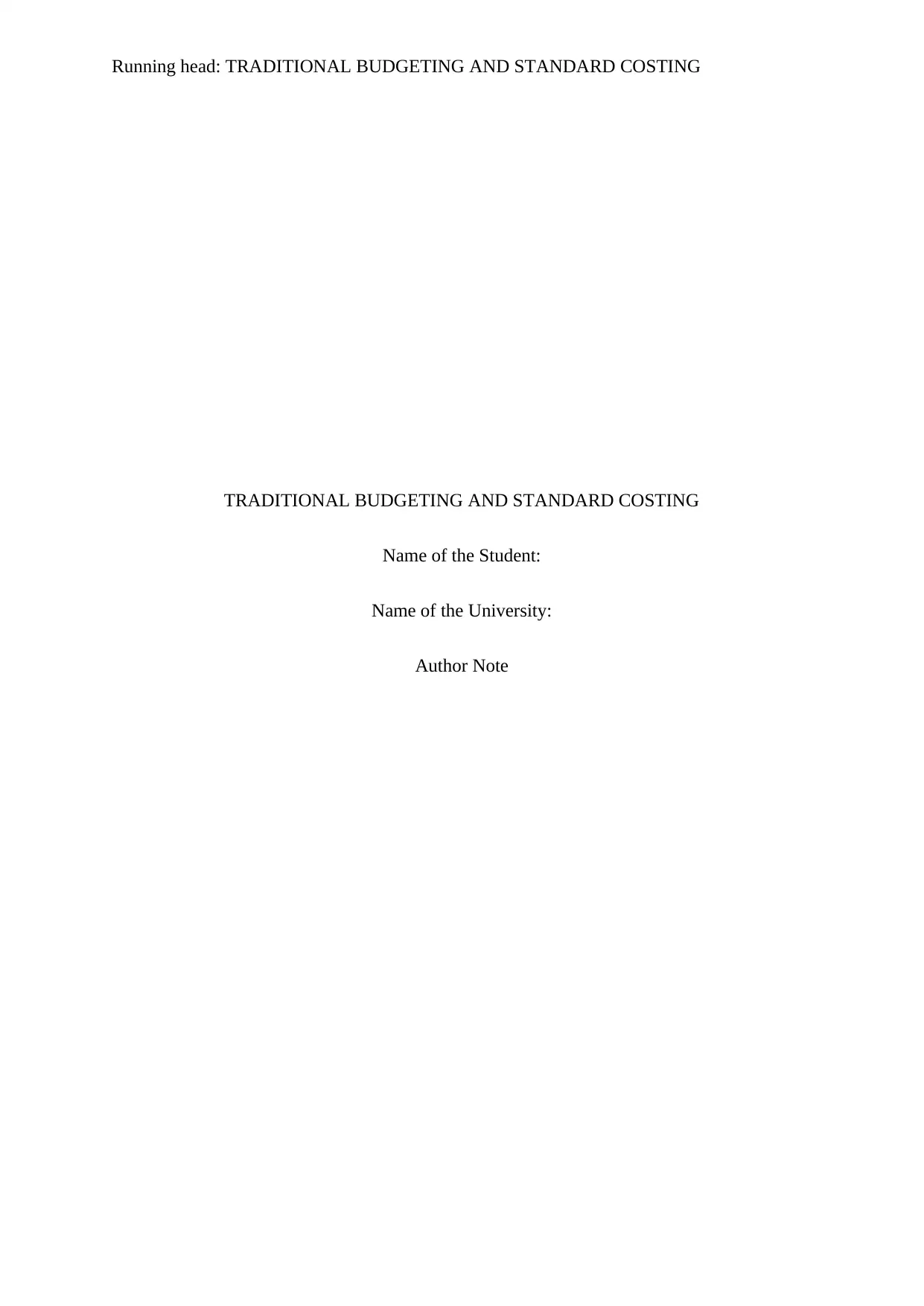
Running head: TRADITIONAL BUDGETING AND STANDARD COSTING
TRADITIONAL BUDGETING AND STANDARD COSTING
Name of the Student:
Name of the University:
Author Note
TRADITIONAL BUDGETING AND STANDARD COSTING
Name of the Student:
Name of the University:
Author Note
Paraphrase This Document
Need a fresh take? Get an instant paraphrase of this document with our AI Paraphraser
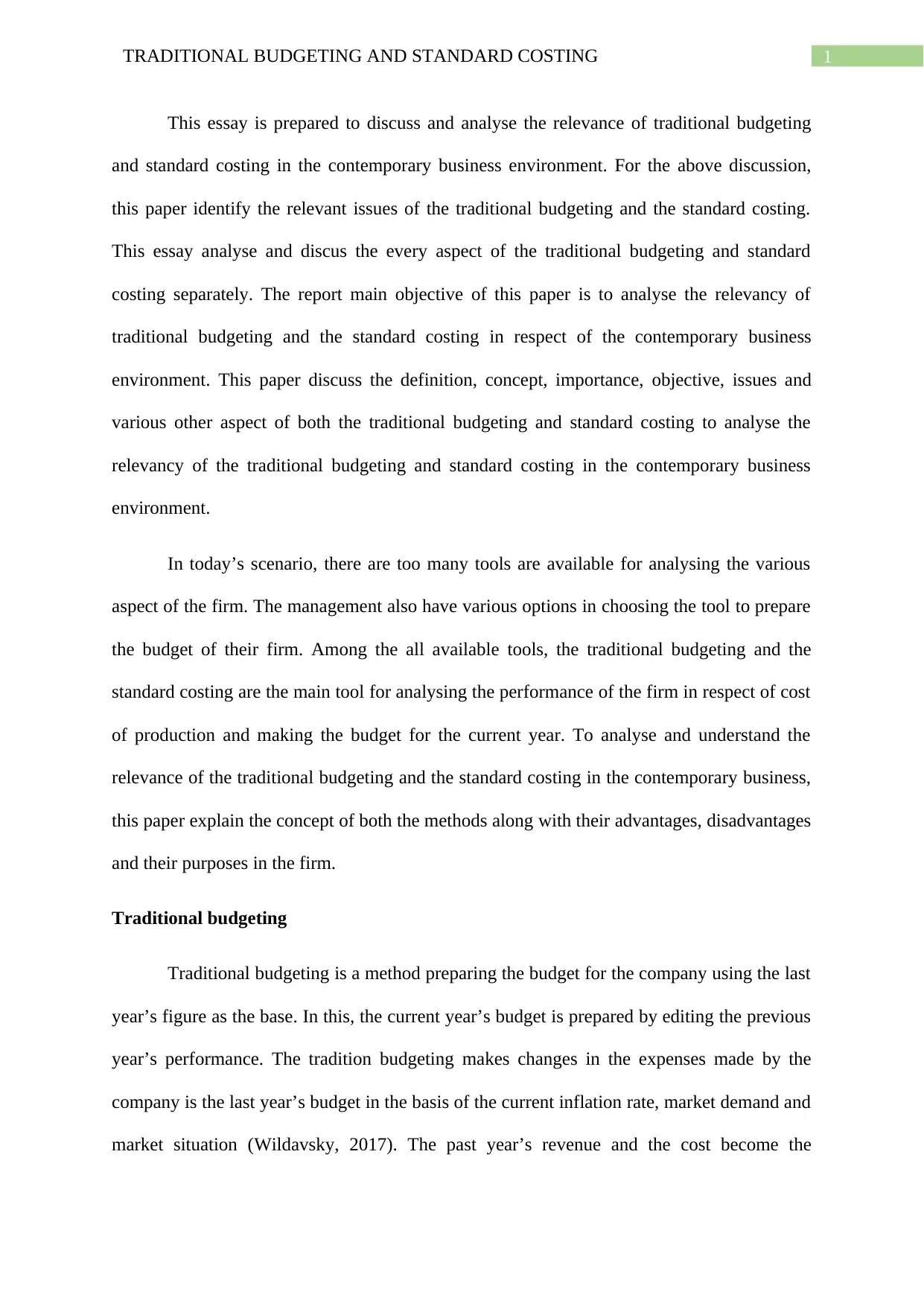
1TRADITIONAL BUDGETING AND STANDARD COSTING
This essay is prepared to discuss and analyse the relevance of traditional budgeting
and standard costing in the contemporary business environment. For the above discussion,
this paper identify the relevant issues of the traditional budgeting and the standard costing.
This essay analyse and discus the every aspect of the traditional budgeting and standard
costing separately. The report main objective of this paper is to analyse the relevancy of
traditional budgeting and the standard costing in respect of the contemporary business
environment. This paper discuss the definition, concept, importance, objective, issues and
various other aspect of both the traditional budgeting and standard costing to analyse the
relevancy of the traditional budgeting and standard costing in the contemporary business
environment.
In today’s scenario, there are too many tools are available for analysing the various
aspect of the firm. The management also have various options in choosing the tool to prepare
the budget of their firm. Among the all available tools, the traditional budgeting and the
standard costing are the main tool for analysing the performance of the firm in respect of cost
of production and making the budget for the current year. To analyse and understand the
relevance of the traditional budgeting and the standard costing in the contemporary business,
this paper explain the concept of both the methods along with their advantages, disadvantages
and their purposes in the firm.
Traditional budgeting
Traditional budgeting is a method preparing the budget for the company using the last
year’s figure as the base. In this, the current year’s budget is prepared by editing the previous
year’s performance. The tradition budgeting makes changes in the expenses made by the
company is the last year’s budget in the basis of the current inflation rate, market demand and
market situation (Wildavsky, 2017). The past year’s revenue and the cost become the
This essay is prepared to discuss and analyse the relevance of traditional budgeting
and standard costing in the contemporary business environment. For the above discussion,
this paper identify the relevant issues of the traditional budgeting and the standard costing.
This essay analyse and discus the every aspect of the traditional budgeting and standard
costing separately. The report main objective of this paper is to analyse the relevancy of
traditional budgeting and the standard costing in respect of the contemporary business
environment. This paper discuss the definition, concept, importance, objective, issues and
various other aspect of both the traditional budgeting and standard costing to analyse the
relevancy of the traditional budgeting and standard costing in the contemporary business
environment.
In today’s scenario, there are too many tools are available for analysing the various
aspect of the firm. The management also have various options in choosing the tool to prepare
the budget of their firm. Among the all available tools, the traditional budgeting and the
standard costing are the main tool for analysing the performance of the firm in respect of cost
of production and making the budget for the current year. To analyse and understand the
relevance of the traditional budgeting and the standard costing in the contemporary business,
this paper explain the concept of both the methods along with their advantages, disadvantages
and their purposes in the firm.
Traditional budgeting
Traditional budgeting is a method preparing the budget for the company using the last
year’s figure as the base. In this, the current year’s budget is prepared by editing the previous
year’s performance. The tradition budgeting makes changes in the expenses made by the
company is the last year’s budget in the basis of the current inflation rate, market demand and
market situation (Wildavsky, 2017). The past year’s revenue and the cost become the
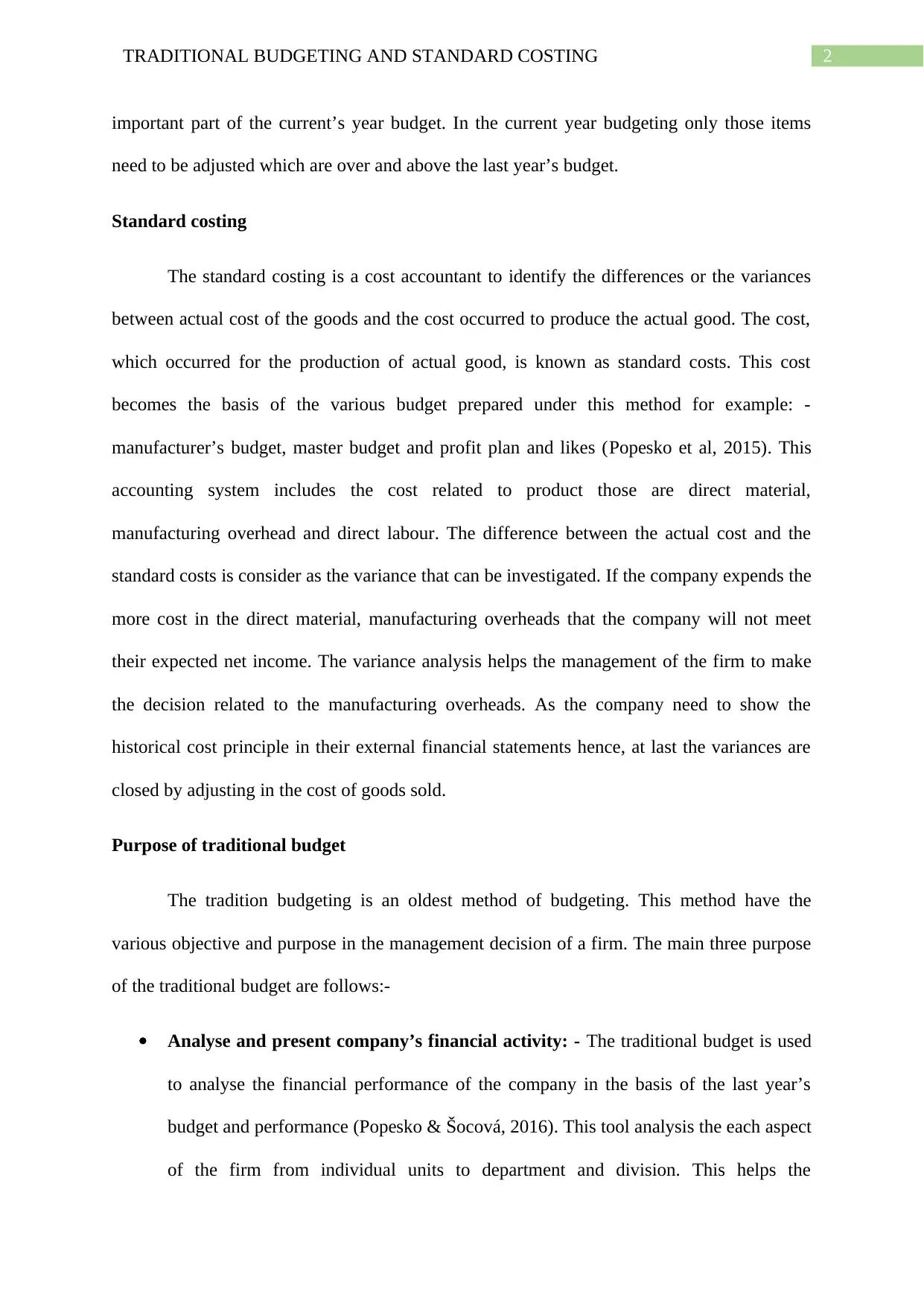
2TRADITIONAL BUDGETING AND STANDARD COSTING
important part of the current’s year budget. In the current year budgeting only those items
need to be adjusted which are over and above the last year’s budget.
Standard costing
The standard costing is a cost accountant to identify the differences or the variances
between actual cost of the goods and the cost occurred to produce the actual good. The cost,
which occurred for the production of actual good, is known as standard costs. This cost
becomes the basis of the various budget prepared under this method for example: -
manufacturer’s budget, master budget and profit plan and likes (Popesko et al, 2015). This
accounting system includes the cost related to product those are direct material,
manufacturing overhead and direct labour. The difference between the actual cost and the
standard costs is consider as the variance that can be investigated. If the company expends the
more cost in the direct material, manufacturing overheads that the company will not meet
their expected net income. The variance analysis helps the management of the firm to make
the decision related to the manufacturing overheads. As the company need to show the
historical cost principle in their external financial statements hence, at last the variances are
closed by adjusting in the cost of goods sold.
Purpose of traditional budget
The tradition budgeting is an oldest method of budgeting. This method have the
various objective and purpose in the management decision of a firm. The main three purpose
of the traditional budget are follows:-
Analyse and present company’s financial activity: - The traditional budget is used
to analyse the financial performance of the company in the basis of the last year’s
budget and performance (Popesko & Šocová, 2016). This tool analysis the each aspect
of the firm from individual units to department and division. This helps the
important part of the current’s year budget. In the current year budgeting only those items
need to be adjusted which are over and above the last year’s budget.
Standard costing
The standard costing is a cost accountant to identify the differences or the variances
between actual cost of the goods and the cost occurred to produce the actual good. The cost,
which occurred for the production of actual good, is known as standard costs. This cost
becomes the basis of the various budget prepared under this method for example: -
manufacturer’s budget, master budget and profit plan and likes (Popesko et al, 2015). This
accounting system includes the cost related to product those are direct material,
manufacturing overhead and direct labour. The difference between the actual cost and the
standard costs is consider as the variance that can be investigated. If the company expends the
more cost in the direct material, manufacturing overheads that the company will not meet
their expected net income. The variance analysis helps the management of the firm to make
the decision related to the manufacturing overheads. As the company need to show the
historical cost principle in their external financial statements hence, at last the variances are
closed by adjusting in the cost of goods sold.
Purpose of traditional budget
The tradition budgeting is an oldest method of budgeting. This method have the
various objective and purpose in the management decision of a firm. The main three purpose
of the traditional budget are follows:-
Analyse and present company’s financial activity: - The traditional budget is used
to analyse the financial performance of the company in the basis of the last year’s
budget and performance (Popesko & Šocová, 2016). This tool analysis the each aspect
of the firm from individual units to department and division. This helps the
⊘ This is a preview!⊘
Do you want full access?
Subscribe today to unlock all pages.

Trusted by 1+ million students worldwide

3TRADITIONAL BUDGETING AND STANDARD COSTING
management to analyse the each aspect of the firm more clearly and provide a clear
picture of the operational strategic goals and objectives. Budgeting is not all about the
profit planning, it aligns the individual units with the organisation’s strategic and
operation goals (Segun & Olamide, 2015). Mainly, the budgeting means the allocation
of the resources, which helps the management to make decision related to the revenue
and the cost saving. After analysing the performance of the firm it system also report
the financial performance of the firm.
Communicating financial plans: - The traditional budgeting also communicates the
objective and goal of the firm among the difference departments and sections of the
firm. This budgeting has the budget centres, which control the various aspect of the
firm and communicates through it. As the traditional budget involves high level of
details, this helps the management to perform the central control over the different
aspects of the firm.
Motivating individuals: - This system motivates the user as this system provides the
authority for expenditure so that they can use this power to achieve the objective and
goals. This is also the most debatable performance of the budgeting as it promotes the
dysfunctional behaviours.
Purpose of Standard Costing
The standard costing is fully based on the overhead expenses made by the company to
produce the product or services and analyse the performance using the variance of the cost.
The followings are the some important purposes of the standard costing:-
Establishing budgets: - The standard costing method helps the management to
prepare the budget. The standard costing develops the budget for the expenses related
management to analyse the each aspect of the firm more clearly and provide a clear
picture of the operational strategic goals and objectives. Budgeting is not all about the
profit planning, it aligns the individual units with the organisation’s strategic and
operation goals (Segun & Olamide, 2015). Mainly, the budgeting means the allocation
of the resources, which helps the management to make decision related to the revenue
and the cost saving. After analysing the performance of the firm it system also report
the financial performance of the firm.
Communicating financial plans: - The traditional budgeting also communicates the
objective and goal of the firm among the difference departments and sections of the
firm. This budgeting has the budget centres, which control the various aspect of the
firm and communicates through it. As the traditional budget involves high level of
details, this helps the management to perform the central control over the different
aspects of the firm.
Motivating individuals: - This system motivates the user as this system provides the
authority for expenditure so that they can use this power to achieve the objective and
goals. This is also the most debatable performance of the budgeting as it promotes the
dysfunctional behaviours.
Purpose of Standard Costing
The standard costing is fully based on the overhead expenses made by the company to
produce the product or services and analyse the performance using the variance of the cost.
The followings are the some important purposes of the standard costing:-
Establishing budgets: - The standard costing method helps the management to
prepare the budget. The standard costing develops the budget for the expenses related
Paraphrase This Document
Need a fresh take? Get an instant paraphrase of this document with our AI Paraphraser
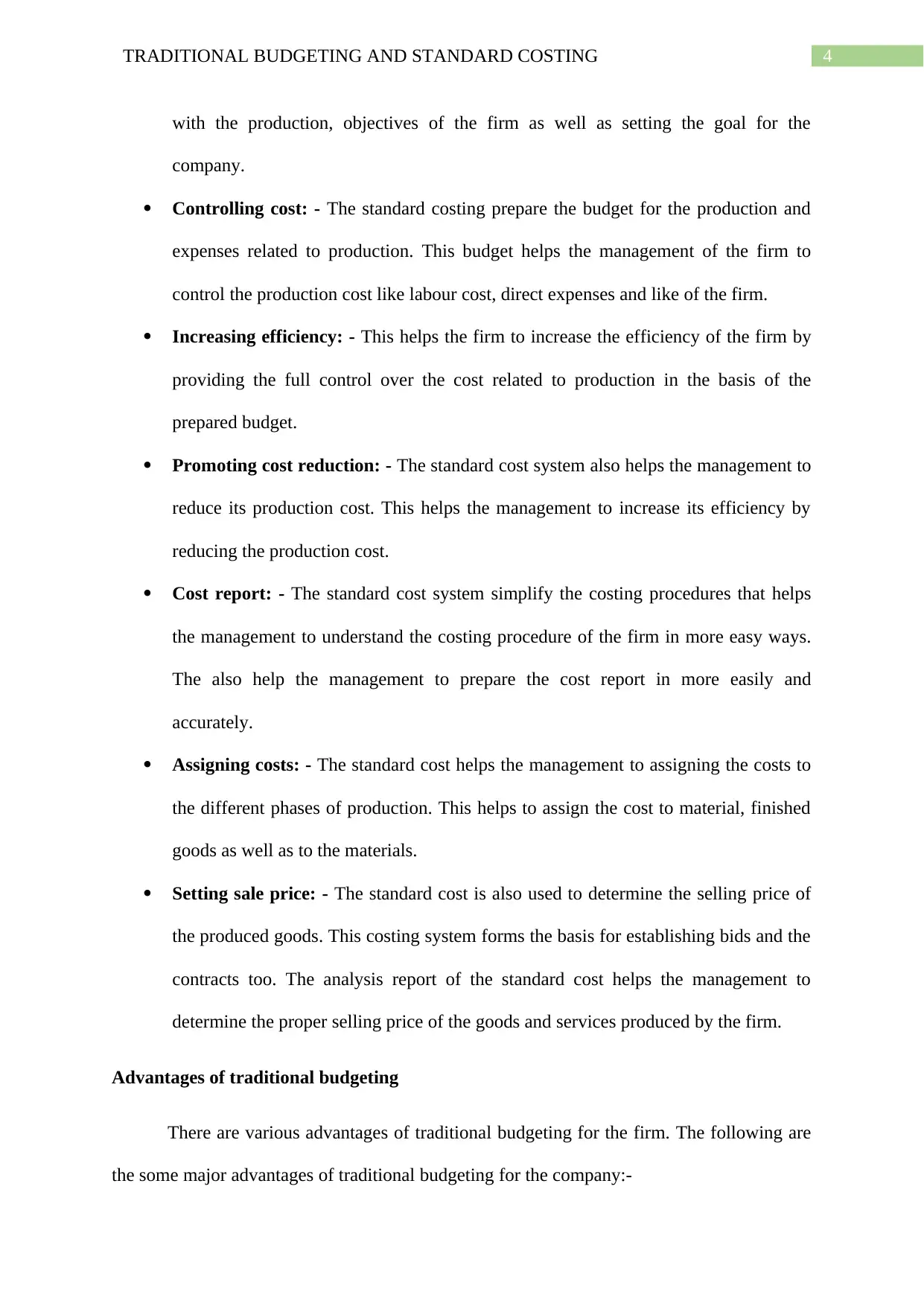
4TRADITIONAL BUDGETING AND STANDARD COSTING
with the production, objectives of the firm as well as setting the goal for the
company.
Controlling cost: - The standard costing prepare the budget for the production and
expenses related to production. This budget helps the management of the firm to
control the production cost like labour cost, direct expenses and like of the firm.
Increasing efficiency: - This helps the firm to increase the efficiency of the firm by
providing the full control over the cost related to production in the basis of the
prepared budget.
Promoting cost reduction: - The standard cost system also helps the management to
reduce its production cost. This helps the management to increase its efficiency by
reducing the production cost.
Cost report: - The standard cost system simplify the costing procedures that helps
the management to understand the costing procedure of the firm in more easy ways.
The also help the management to prepare the cost report in more easily and
accurately.
Assigning costs: - The standard cost helps the management to assigning the costs to
the different phases of production. This helps to assign the cost to material, finished
goods as well as to the materials.
Setting sale price: - The standard cost is also used to determine the selling price of
the produced goods. This costing system forms the basis for establishing bids and the
contracts too. The analysis report of the standard cost helps the management to
determine the proper selling price of the goods and services produced by the firm.
Advantages of traditional budgeting
There are various advantages of traditional budgeting for the firm. The following are
the some major advantages of traditional budgeting for the company:-
with the production, objectives of the firm as well as setting the goal for the
company.
Controlling cost: - The standard costing prepare the budget for the production and
expenses related to production. This budget helps the management of the firm to
control the production cost like labour cost, direct expenses and like of the firm.
Increasing efficiency: - This helps the firm to increase the efficiency of the firm by
providing the full control over the cost related to production in the basis of the
prepared budget.
Promoting cost reduction: - The standard cost system also helps the management to
reduce its production cost. This helps the management to increase its efficiency by
reducing the production cost.
Cost report: - The standard cost system simplify the costing procedures that helps
the management to understand the costing procedure of the firm in more easy ways.
The also help the management to prepare the cost report in more easily and
accurately.
Assigning costs: - The standard cost helps the management to assigning the costs to
the different phases of production. This helps to assign the cost to material, finished
goods as well as to the materials.
Setting sale price: - The standard cost is also used to determine the selling price of
the produced goods. This costing system forms the basis for establishing bids and the
contracts too. The analysis report of the standard cost helps the management to
determine the proper selling price of the goods and services produced by the firm.
Advantages of traditional budgeting
There are various advantages of traditional budgeting for the firm. The following are
the some major advantages of traditional budgeting for the company:-
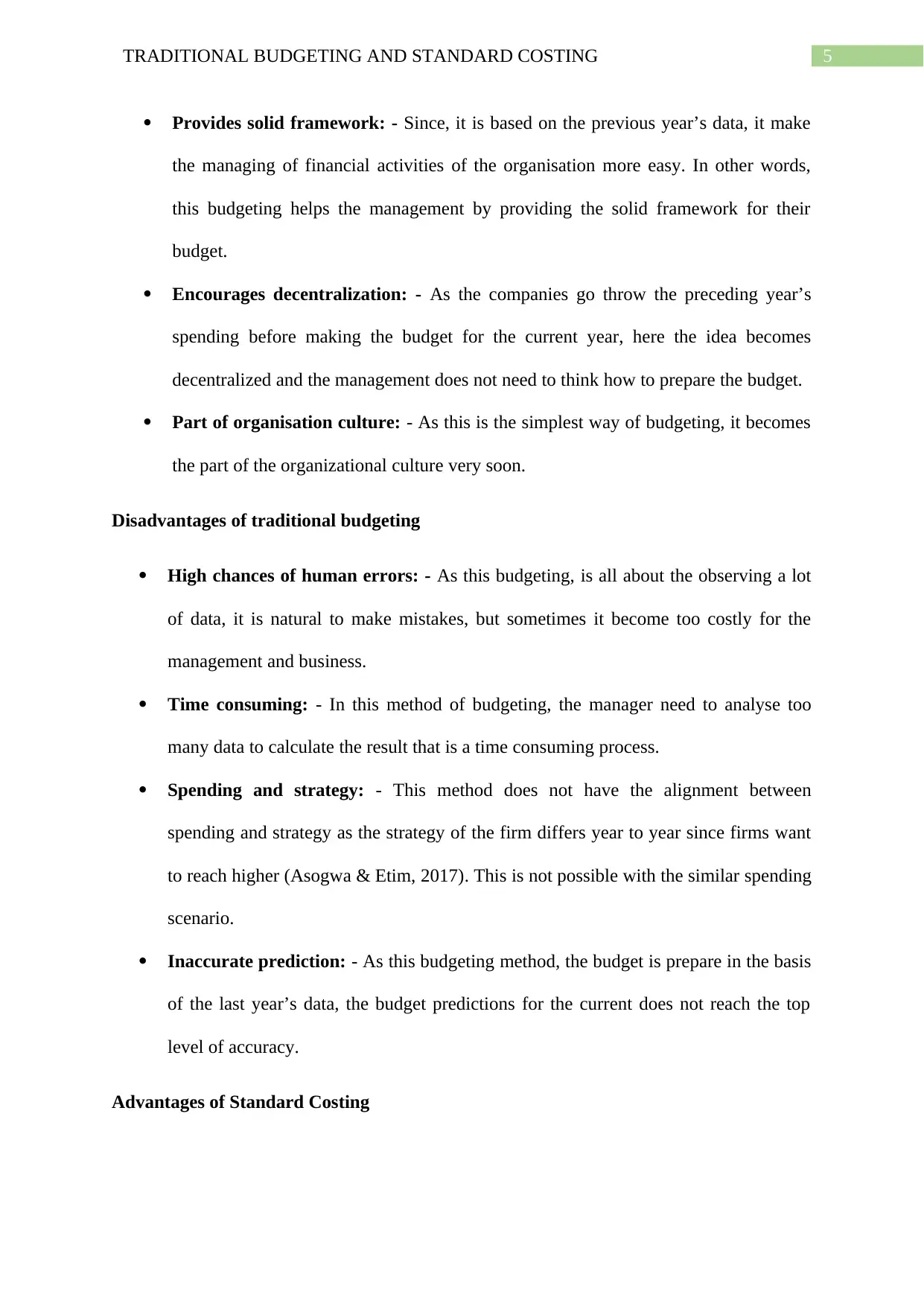
5TRADITIONAL BUDGETING AND STANDARD COSTING
Provides solid framework: - Since, it is based on the previous year’s data, it make
the managing of financial activities of the organisation more easy. In other words,
this budgeting helps the management by providing the solid framework for their
budget.
Encourages decentralization: - As the companies go throw the preceding year’s
spending before making the budget for the current year, here the idea becomes
decentralized and the management does not need to think how to prepare the budget.
Part of organisation culture: - As this is the simplest way of budgeting, it becomes
the part of the organizational culture very soon.
Disadvantages of traditional budgeting
High chances of human errors: - As this budgeting, is all about the observing a lot
of data, it is natural to make mistakes, but sometimes it become too costly for the
management and business.
Time consuming: - In this method of budgeting, the manager need to analyse too
many data to calculate the result that is a time consuming process.
Spending and strategy: - This method does not have the alignment between
spending and strategy as the strategy of the firm differs year to year since firms want
to reach higher (Asogwa & Etim, 2017). This is not possible with the similar spending
scenario.
Inaccurate prediction: - As this budgeting method, the budget is prepare in the basis
of the last year’s data, the budget predictions for the current does not reach the top
level of accuracy.
Advantages of Standard Costing
Provides solid framework: - Since, it is based on the previous year’s data, it make
the managing of financial activities of the organisation more easy. In other words,
this budgeting helps the management by providing the solid framework for their
budget.
Encourages decentralization: - As the companies go throw the preceding year’s
spending before making the budget for the current year, here the idea becomes
decentralized and the management does not need to think how to prepare the budget.
Part of organisation culture: - As this is the simplest way of budgeting, it becomes
the part of the organizational culture very soon.
Disadvantages of traditional budgeting
High chances of human errors: - As this budgeting, is all about the observing a lot
of data, it is natural to make mistakes, but sometimes it become too costly for the
management and business.
Time consuming: - In this method of budgeting, the manager need to analyse too
many data to calculate the result that is a time consuming process.
Spending and strategy: - This method does not have the alignment between
spending and strategy as the strategy of the firm differs year to year since firms want
to reach higher (Asogwa & Etim, 2017). This is not possible with the similar spending
scenario.
Inaccurate prediction: - As this budgeting method, the budget is prepare in the basis
of the last year’s data, the budget predictions for the current does not reach the top
level of accuracy.
Advantages of Standard Costing
⊘ This is a preview!⊘
Do you want full access?
Subscribe today to unlock all pages.

Trusted by 1+ million students worldwide
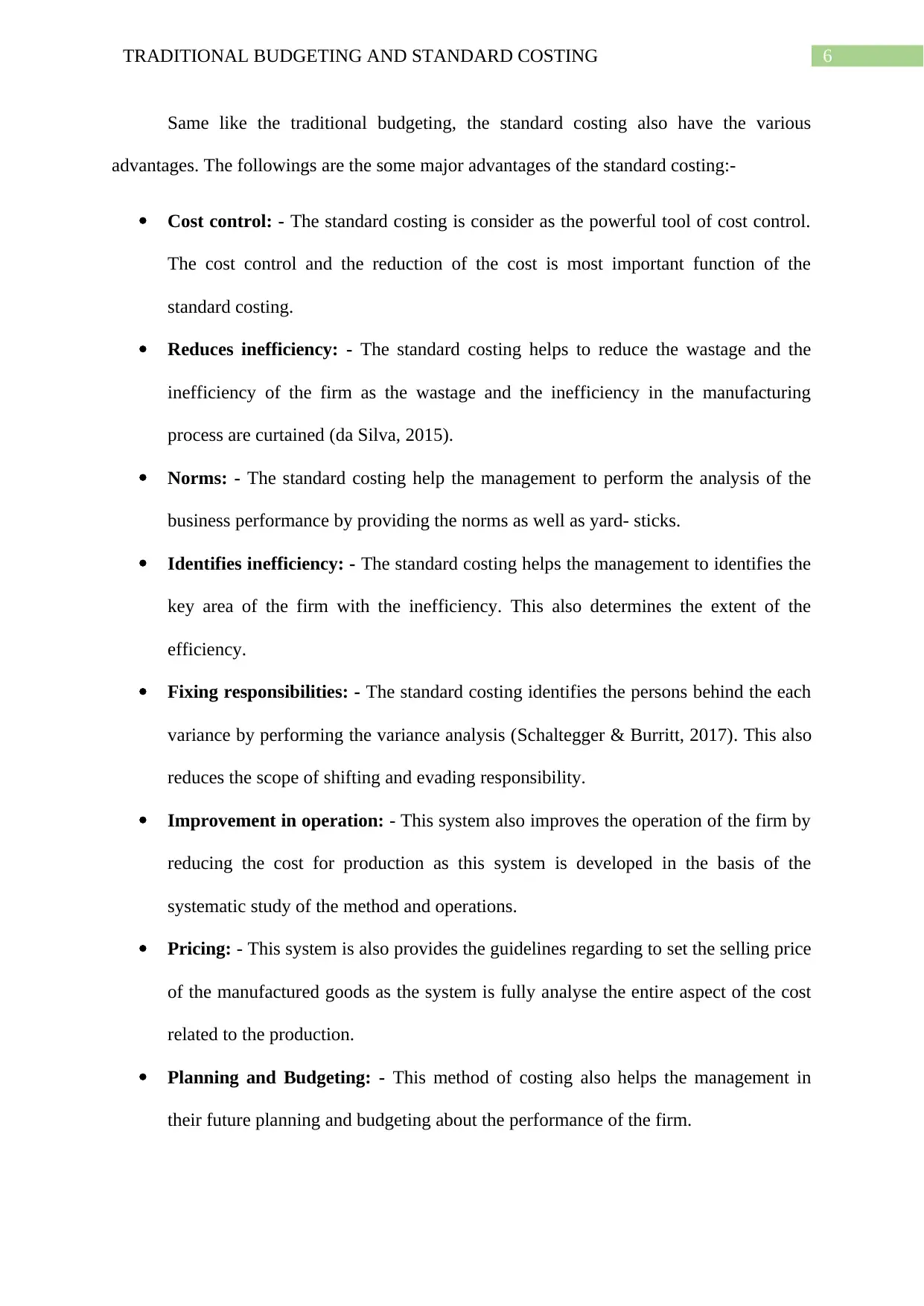
6TRADITIONAL BUDGETING AND STANDARD COSTING
Same like the traditional budgeting, the standard costing also have the various
advantages. The followings are the some major advantages of the standard costing:-
Cost control: - The standard costing is consider as the powerful tool of cost control.
The cost control and the reduction of the cost is most important function of the
standard costing.
Reduces inefficiency: - The standard costing helps to reduce the wastage and the
inefficiency of the firm as the wastage and the inefficiency in the manufacturing
process are curtained (da Silva, 2015).
Norms: - The standard costing help the management to perform the analysis of the
business performance by providing the norms as well as yard- sticks.
Identifies inefficiency: - The standard costing helps the management to identifies the
key area of the firm with the inefficiency. This also determines the extent of the
efficiency.
Fixing responsibilities: - The standard costing identifies the persons behind the each
variance by performing the variance analysis (Schaltegger & Burritt, 2017). This also
reduces the scope of shifting and evading responsibility.
Improvement in operation: - This system also improves the operation of the firm by
reducing the cost for production as this system is developed in the basis of the
systematic study of the method and operations.
Pricing: - This system is also provides the guidelines regarding to set the selling price
of the manufactured goods as the system is fully analyse the entire aspect of the cost
related to the production.
Planning and Budgeting: - This method of costing also helps the management in
their future planning and budgeting about the performance of the firm.
Same like the traditional budgeting, the standard costing also have the various
advantages. The followings are the some major advantages of the standard costing:-
Cost control: - The standard costing is consider as the powerful tool of cost control.
The cost control and the reduction of the cost is most important function of the
standard costing.
Reduces inefficiency: - The standard costing helps to reduce the wastage and the
inefficiency of the firm as the wastage and the inefficiency in the manufacturing
process are curtained (da Silva, 2015).
Norms: - The standard costing help the management to perform the analysis of the
business performance by providing the norms as well as yard- sticks.
Identifies inefficiency: - The standard costing helps the management to identifies the
key area of the firm with the inefficiency. This also determines the extent of the
efficiency.
Fixing responsibilities: - The standard costing identifies the persons behind the each
variance by performing the variance analysis (Schaltegger & Burritt, 2017). This also
reduces the scope of shifting and evading responsibility.
Improvement in operation: - This system also improves the operation of the firm by
reducing the cost for production as this system is developed in the basis of the
systematic study of the method and operations.
Pricing: - This system is also provides the guidelines regarding to set the selling price
of the manufactured goods as the system is fully analyse the entire aspect of the cost
related to the production.
Planning and Budgeting: - This method of costing also helps the management in
their future planning and budgeting about the performance of the firm.
Paraphrase This Document
Need a fresh take? Get an instant paraphrase of this document with our AI Paraphraser
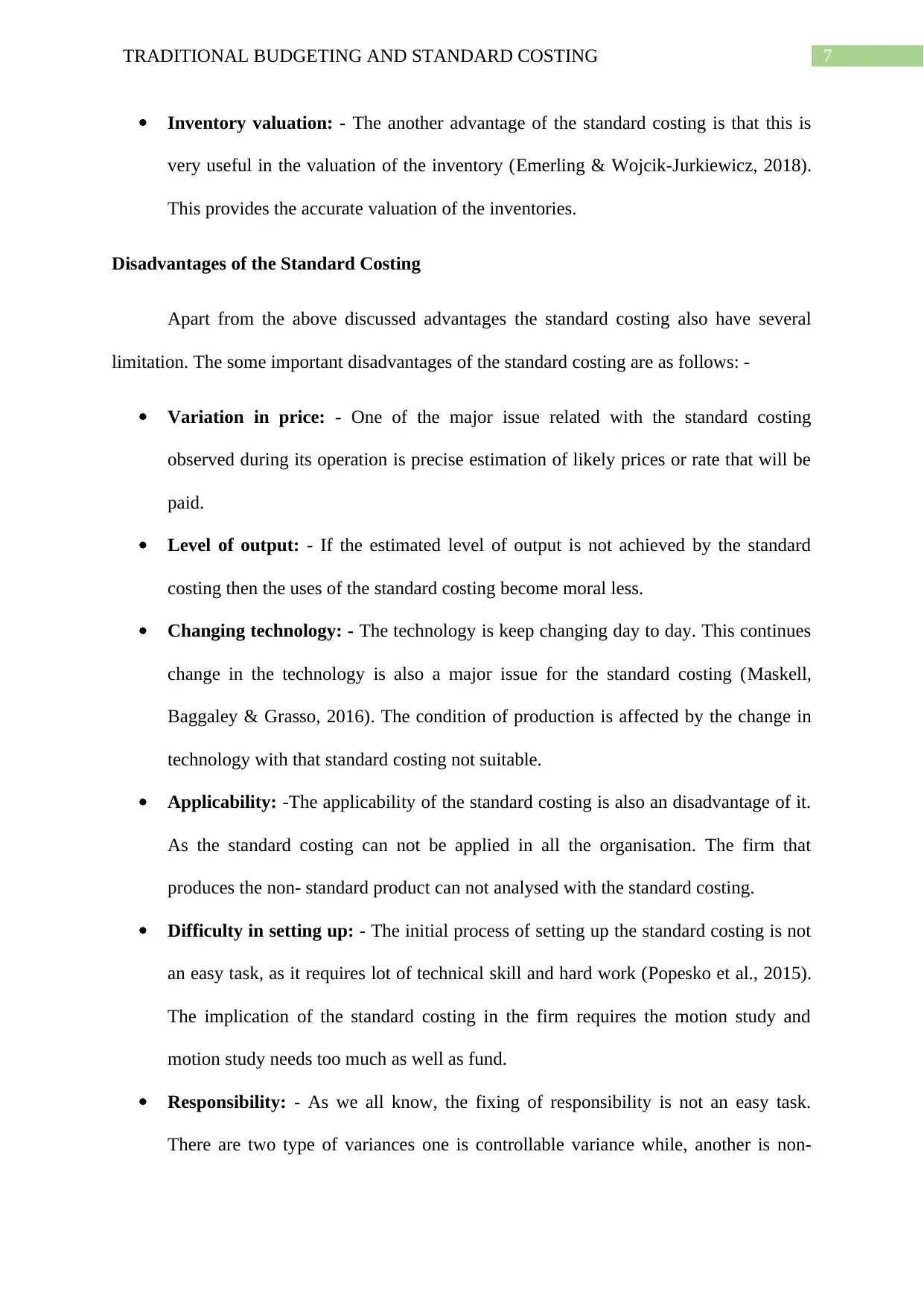
7TRADITIONAL BUDGETING AND STANDARD COSTING
Inventory valuation: - The another advantage of the standard costing is that this is
very useful in the valuation of the inventory (Emerling & Wojcik-Jurkiewicz, 2018).
This provides the accurate valuation of the inventories.
Disadvantages of the Standard Costing
Apart from the above discussed advantages the standard costing also have several
limitation. The some important disadvantages of the standard costing are as follows: -
Variation in price: - One of the major issue related with the standard costing
observed during its operation is precise estimation of likely prices or rate that will be
paid.
Level of output: - If the estimated level of output is not achieved by the standard
costing then the uses of the standard costing become moral less.
Changing technology: - The technology is keep changing day to day. This continues
change in the technology is also a major issue for the standard costing (Maskell,
Baggaley & Grasso, 2016). The condition of production is affected by the change in
technology with that standard costing not suitable.
Applicability: -The applicability of the standard costing is also an disadvantage of it.
As the standard costing can not be applied in all the organisation. The firm that
produces the non- standard product can not analysed with the standard costing.
Difficulty in setting up: - The initial process of setting up the standard costing is not
an easy task, as it requires lot of technical skill and hard work (Popesko et al., 2015).
The implication of the standard costing in the firm requires the motion study and
motion study needs too much as well as fund.
Responsibility: - As we all know, the fixing of responsibility is not an easy task.
There are two type of variances one is controllable variance while, another is non-
Inventory valuation: - The another advantage of the standard costing is that this is
very useful in the valuation of the inventory (Emerling & Wojcik-Jurkiewicz, 2018).
This provides the accurate valuation of the inventories.
Disadvantages of the Standard Costing
Apart from the above discussed advantages the standard costing also have several
limitation. The some important disadvantages of the standard costing are as follows: -
Variation in price: - One of the major issue related with the standard costing
observed during its operation is precise estimation of likely prices or rate that will be
paid.
Level of output: - If the estimated level of output is not achieved by the standard
costing then the uses of the standard costing become moral less.
Changing technology: - The technology is keep changing day to day. This continues
change in the technology is also a major issue for the standard costing (Maskell,
Baggaley & Grasso, 2016). The condition of production is affected by the change in
technology with that standard costing not suitable.
Applicability: -The applicability of the standard costing is also an disadvantage of it.
As the standard costing can not be applied in all the organisation. The firm that
produces the non- standard product can not analysed with the standard costing.
Difficulty in setting up: - The initial process of setting up the standard costing is not
an easy task, as it requires lot of technical skill and hard work (Popesko et al., 2015).
The implication of the standard costing in the firm requires the motion study and
motion study needs too much as well as fund.
Responsibility: - As we all know, the fixing of responsibility is not an easy task.
There are two type of variances one is controllable variance while, another is non-
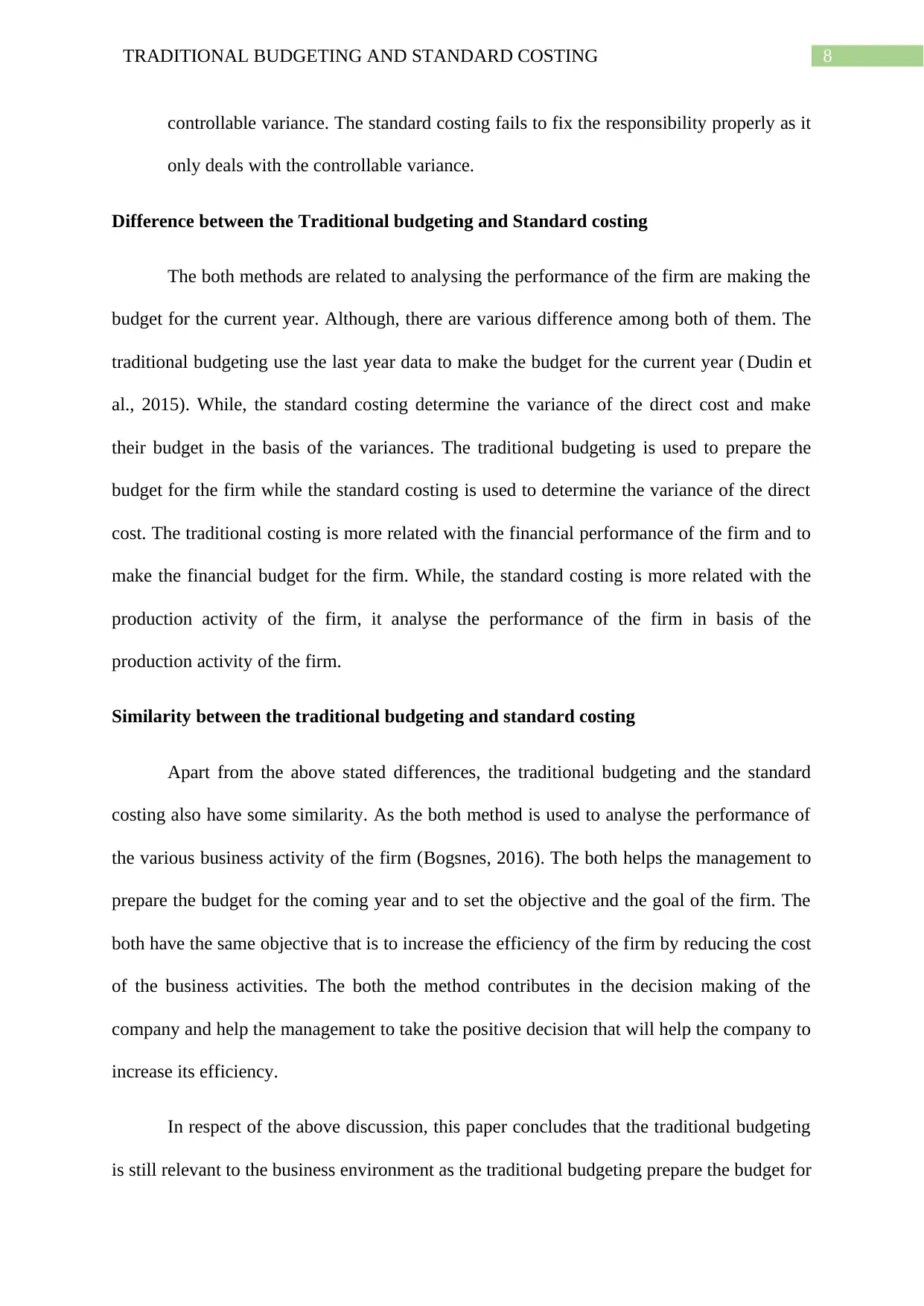
8TRADITIONAL BUDGETING AND STANDARD COSTING
controllable variance. The standard costing fails to fix the responsibility properly as it
only deals with the controllable variance.
Difference between the Traditional budgeting and Standard costing
The both methods are related to analysing the performance of the firm are making the
budget for the current year. Although, there are various difference among both of them. The
traditional budgeting use the last year data to make the budget for the current year (Dudin et
al., 2015). While, the standard costing determine the variance of the direct cost and make
their budget in the basis of the variances. The traditional budgeting is used to prepare the
budget for the firm while the standard costing is used to determine the variance of the direct
cost. The traditional costing is more related with the financial performance of the firm and to
make the financial budget for the firm. While, the standard costing is more related with the
production activity of the firm, it analyse the performance of the firm in basis of the
production activity of the firm.
Similarity between the traditional budgeting and standard costing
Apart from the above stated differences, the traditional budgeting and the standard
costing also have some similarity. As the both method is used to analyse the performance of
the various business activity of the firm (Bogsnes, 2016). The both helps the management to
prepare the budget for the coming year and to set the objective and the goal of the firm. The
both have the same objective that is to increase the efficiency of the firm by reducing the cost
of the business activities. The both the method contributes in the decision making of the
company and help the management to take the positive decision that will help the company to
increase its efficiency.
In respect of the above discussion, this paper concludes that the traditional budgeting
is still relevant to the business environment as the traditional budgeting prepare the budget for
controllable variance. The standard costing fails to fix the responsibility properly as it
only deals with the controllable variance.
Difference between the Traditional budgeting and Standard costing
The both methods are related to analysing the performance of the firm are making the
budget for the current year. Although, there are various difference among both of them. The
traditional budgeting use the last year data to make the budget for the current year (Dudin et
al., 2015). While, the standard costing determine the variance of the direct cost and make
their budget in the basis of the variances. The traditional budgeting is used to prepare the
budget for the firm while the standard costing is used to determine the variance of the direct
cost. The traditional costing is more related with the financial performance of the firm and to
make the financial budget for the firm. While, the standard costing is more related with the
production activity of the firm, it analyse the performance of the firm in basis of the
production activity of the firm.
Similarity between the traditional budgeting and standard costing
Apart from the above stated differences, the traditional budgeting and the standard
costing also have some similarity. As the both method is used to analyse the performance of
the various business activity of the firm (Bogsnes, 2016). The both helps the management to
prepare the budget for the coming year and to set the objective and the goal of the firm. The
both have the same objective that is to increase the efficiency of the firm by reducing the cost
of the business activities. The both the method contributes in the decision making of the
company and help the management to take the positive decision that will help the company to
increase its efficiency.
In respect of the above discussion, this paper concludes that the traditional budgeting
is still relevant to the business environment as the traditional budgeting prepare the budget for
⊘ This is a preview!⊘
Do you want full access?
Subscribe today to unlock all pages.

Trusted by 1+ million students worldwide
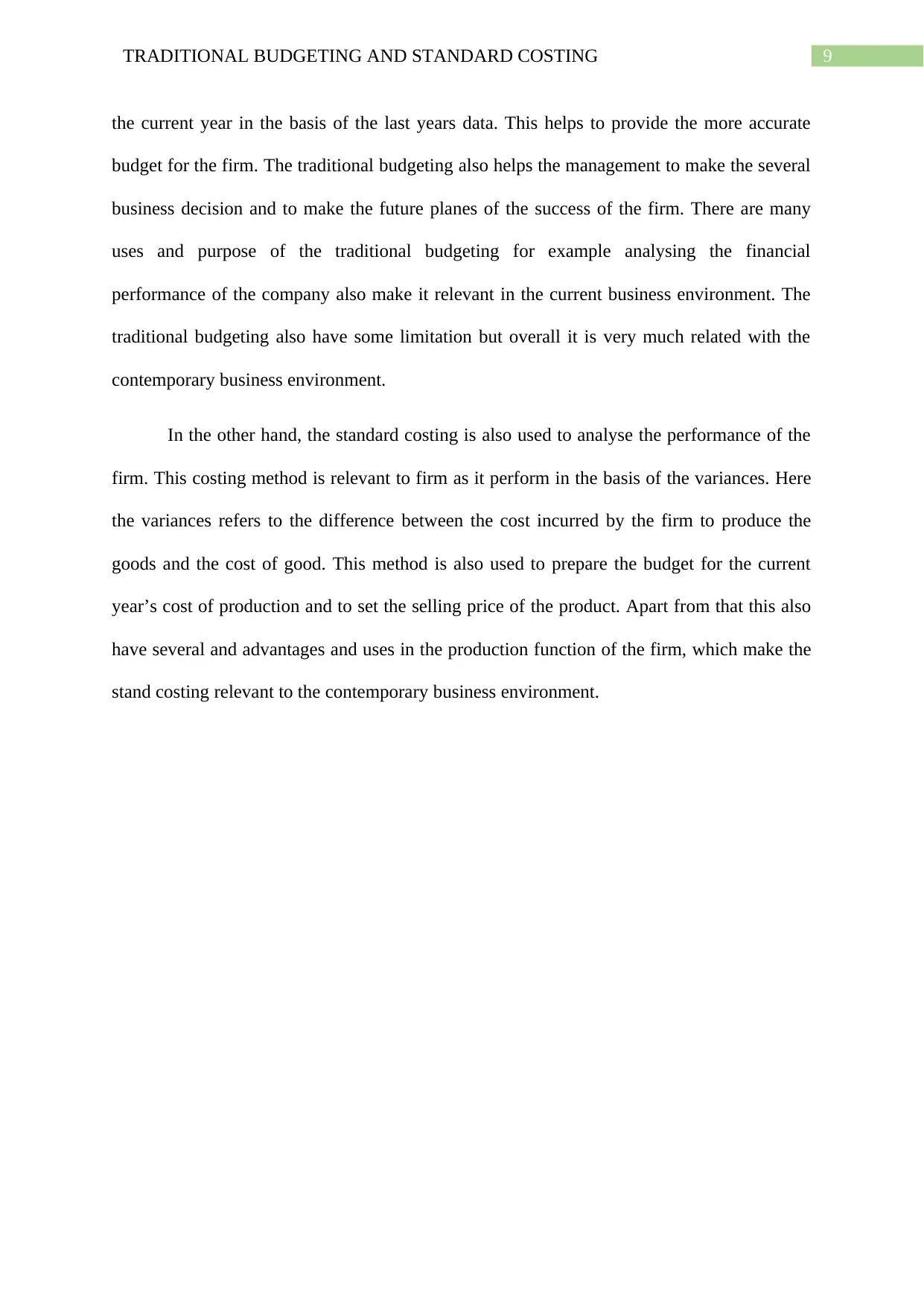
9TRADITIONAL BUDGETING AND STANDARD COSTING
the current year in the basis of the last years data. This helps to provide the more accurate
budget for the firm. The traditional budgeting also helps the management to make the several
business decision and to make the future planes of the success of the firm. There are many
uses and purpose of the traditional budgeting for example analysing the financial
performance of the company also make it relevant in the current business environment. The
traditional budgeting also have some limitation but overall it is very much related with the
contemporary business environment.
In the other hand, the standard costing is also used to analyse the performance of the
firm. This costing method is relevant to firm as it perform in the basis of the variances. Here
the variances refers to the difference between the cost incurred by the firm to produce the
goods and the cost of good. This method is also used to prepare the budget for the current
year’s cost of production and to set the selling price of the product. Apart from that this also
have several and advantages and uses in the production function of the firm, which make the
stand costing relevant to the contemporary business environment.
the current year in the basis of the last years data. This helps to provide the more accurate
budget for the firm. The traditional budgeting also helps the management to make the several
business decision and to make the future planes of the success of the firm. There are many
uses and purpose of the traditional budgeting for example analysing the financial
performance of the company also make it relevant in the current business environment. The
traditional budgeting also have some limitation but overall it is very much related with the
contemporary business environment.
In the other hand, the standard costing is also used to analyse the performance of the
firm. This costing method is relevant to firm as it perform in the basis of the variances. Here
the variances refers to the difference between the cost incurred by the firm to produce the
goods and the cost of good. This method is also used to prepare the budget for the current
year’s cost of production and to set the selling price of the product. Apart from that this also
have several and advantages and uses in the production function of the firm, which make the
stand costing relevant to the contemporary business environment.
Paraphrase This Document
Need a fresh take? Get an instant paraphrase of this document with our AI Paraphraser

10TRADITIONAL BUDGETING AND STANDARD COSTING
References
Asogwa, I. E., & Etim, O. E. (2017). Traditional Budgeting in Today's Business
Environment. Journal of Applied Finance and Banking, 7(3), 111.
Bogsnes, B. (2016). Implementing beyond budgeting: Unlocking the performance potential.
John Wiley & Sons.
Bogsnes, B. (2016). Implementing beyond budgeting: Unlocking the performance potential.
John Wiley & Sons.
da Silva, A. P. S. (2015). Nors case study: traditional budgeting process transformation into
beyond budgeting model.
Dudin, M., Kucuri, G., Fedorova, I., Dzusova, S., & Namitulina, A. (2015). The innovative
business model canvas in the system of effective budgeting. Asian Social
Science, 11(7), 290-296.
Emerling, I., & Wojcik-Jurkiewicz, M. (2018). The Risk Associated with the Replacement of
Traditional Budget with Performance Budgeting in the Public Finance Sector
Management. Ekonomicko-manazerske spektrum, 12(1), 55-63.
Maskell, B. H., Baggaley, B., & Grasso, L. (2016). Practical lean accounting: a proven
system for measuring and managing the lean enterprise. Productivity Press.
Popesko, B., & Šocová, V. (2016). Current trends in budgeting and planning: Czech survey
initial results. International Advances in Economic Research, 22(1), 99-100.
Popesko, B., Novák, P., Papadaki, S., & Hrabec, D. (2015). ARE THE TRADITIONAL
BUDGETS STILL PREVALENT: THE SURVEY OF THE CZECH FIRMS
BUDGETING PRACTICES. Transformations in Business & Economics, 14.
References
Asogwa, I. E., & Etim, O. E. (2017). Traditional Budgeting in Today's Business
Environment. Journal of Applied Finance and Banking, 7(3), 111.
Bogsnes, B. (2016). Implementing beyond budgeting: Unlocking the performance potential.
John Wiley & Sons.
Bogsnes, B. (2016). Implementing beyond budgeting: Unlocking the performance potential.
John Wiley & Sons.
da Silva, A. P. S. (2015). Nors case study: traditional budgeting process transformation into
beyond budgeting model.
Dudin, M., Kucuri, G., Fedorova, I., Dzusova, S., & Namitulina, A. (2015). The innovative
business model canvas in the system of effective budgeting. Asian Social
Science, 11(7), 290-296.
Emerling, I., & Wojcik-Jurkiewicz, M. (2018). The Risk Associated with the Replacement of
Traditional Budget with Performance Budgeting in the Public Finance Sector
Management. Ekonomicko-manazerske spektrum, 12(1), 55-63.
Maskell, B. H., Baggaley, B., & Grasso, L. (2016). Practical lean accounting: a proven
system for measuring and managing the lean enterprise. Productivity Press.
Popesko, B., & Šocová, V. (2016). Current trends in budgeting and planning: Czech survey
initial results. International Advances in Economic Research, 22(1), 99-100.
Popesko, B., Novák, P., Papadaki, S., & Hrabec, D. (2015). ARE THE TRADITIONAL
BUDGETS STILL PREVALENT: THE SURVEY OF THE CZECH FIRMS
BUDGETING PRACTICES. Transformations in Business & Economics, 14.
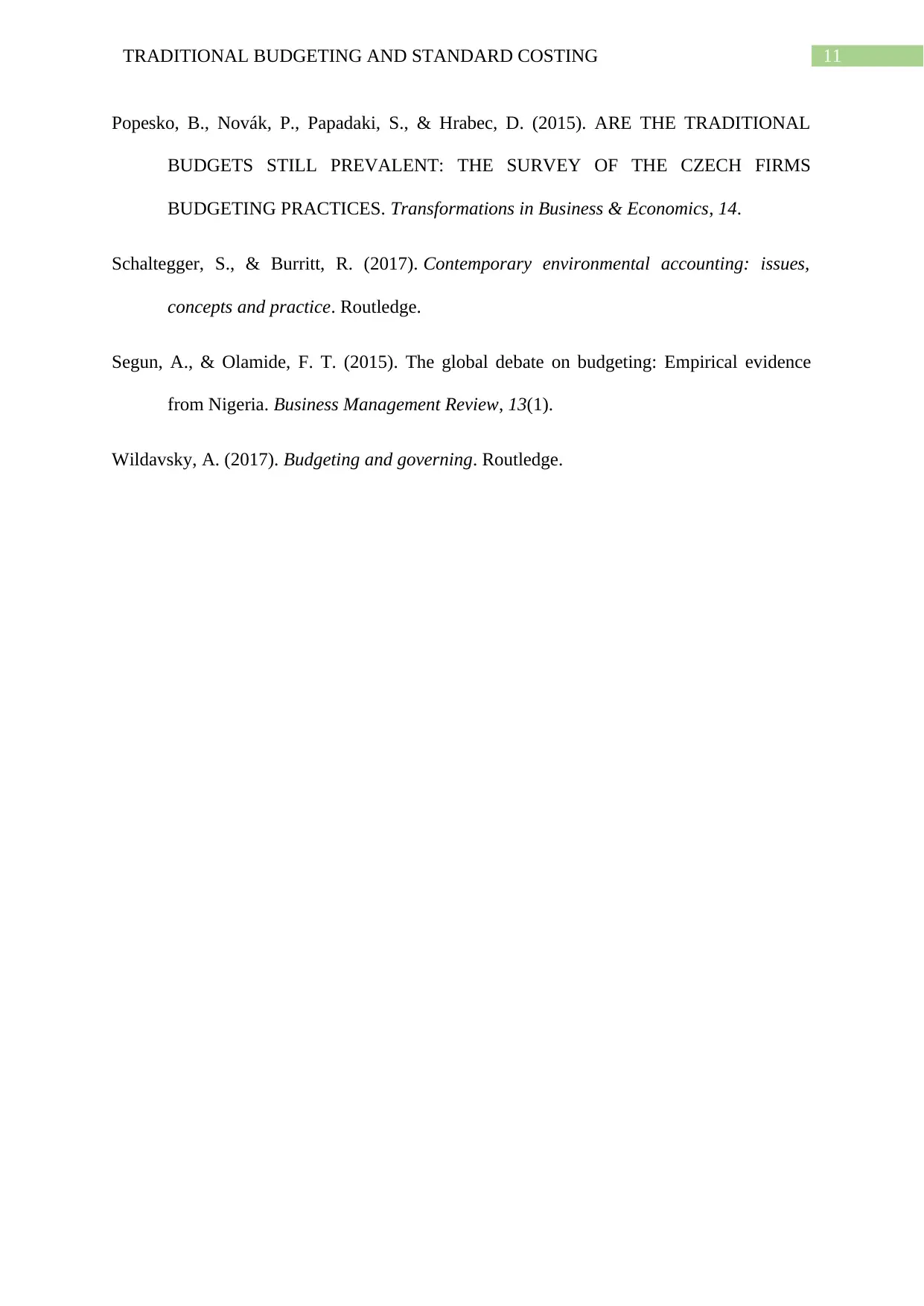
11TRADITIONAL BUDGETING AND STANDARD COSTING
Popesko, B., Novák, P., Papadaki, S., & Hrabec, D. (2015). ARE THE TRADITIONAL
BUDGETS STILL PREVALENT: THE SURVEY OF THE CZECH FIRMS
BUDGETING PRACTICES. Transformations in Business & Economics, 14.
Schaltegger, S., & Burritt, R. (2017). Contemporary environmental accounting: issues,
concepts and practice. Routledge.
Segun, A., & Olamide, F. T. (2015). The global debate on budgeting: Empirical evidence
from Nigeria. Business Management Review, 13(1).
Wildavsky, A. (2017). Budgeting and governing. Routledge.
Popesko, B., Novák, P., Papadaki, S., & Hrabec, D. (2015). ARE THE TRADITIONAL
BUDGETS STILL PREVALENT: THE SURVEY OF THE CZECH FIRMS
BUDGETING PRACTICES. Transformations in Business & Economics, 14.
Schaltegger, S., & Burritt, R. (2017). Contemporary environmental accounting: issues,
concepts and practice. Routledge.
Segun, A., & Olamide, F. T. (2015). The global debate on budgeting: Empirical evidence
from Nigeria. Business Management Review, 13(1).
Wildavsky, A. (2017). Budgeting and governing. Routledge.
⊘ This is a preview!⊘
Do you want full access?
Subscribe today to unlock all pages.

Trusted by 1+ million students worldwide
1 out of 12
Related Documents
Your All-in-One AI-Powered Toolkit for Academic Success.
+13062052269
info@desklib.com
Available 24*7 on WhatsApp / Email
![[object Object]](/_next/static/media/star-bottom.7253800d.svg)
Unlock your academic potential
Copyright © 2020–2025 A2Z Services. All Rights Reserved. Developed and managed by ZUCOL.





